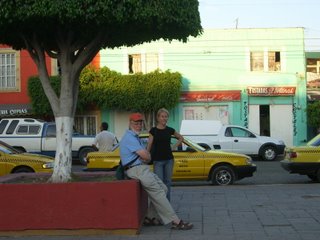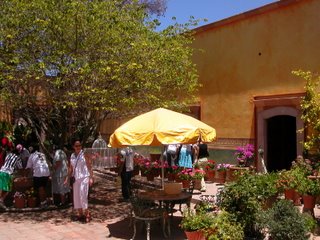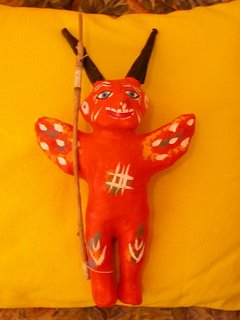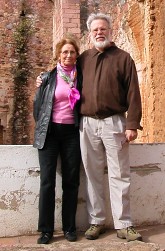(We are now back in Querétaro after returning from our trip to Yucatan in April and our trip back to Atlanta in May. I will try to quickly bring things up to date, just hitting some of the high points. We are presently looking for a house to buy so I may have less time for this than I did before, plus Blogger is very, very, very slow to upload photos. It has taken nearly two days to upload these photos with delays of an hour or more between uploads. Do not use Blogger for your blog.)After leaving Tulum and Coba, we headed to Puerto Morelos to visit Lilia who owns a cultural resources consulting firm and her husband Bill. Lilia has her master’s in archaeology, and like many Mexicans in a similar situation, she has had trouble finding a job in her field. She therefore started her own cultural resources company (unheard of in Mexico), and although she cannot collect artifacts or dig, she can do background research and conduct field surveys for developers and municipal governments, despite an often negative reaction from some Mexican federal agencies.
Puerto Morelos is like Tulum, traditional commercial development along the main north-south highway inland from the Caribbean, and a more recent part of town on the ocean separated from the rest of town by mangrove swamps. All the swamps and jungle from here north were mowed down to about 10 feet above ground level by five days (not hours, days) of hurricane Wilma last fall. New Orleans got something like four to eight hours. The ocean-front part is inhabited by rich Americans who have permanent homes there. It is unlike most of the Maya Riviera (from Cancun to Chetumal) in that it is not made up of big resort hotels, and is very laid-back and low key.
Lilia took us around town and showed us the area where her company has been doing a project for the past year or two. She reminded us that Nellie L. had done the same thing for her when she came to DC last fall for the ACRA conference, and she wanted to do the same for others. She also showed us the house she and Bill are building on ejido land inland from town. They are building it “Mexican style”, doing things when they have the time and money. It is still loaded with Bill’s orchids, despite the storm damage. Lilia has just bought another home in town that she also uses for her work. This house she bought through a special low-interest, governmental mortgage program that promises to help many more people participate in the Mexican dream.
 Lilia's house in what used to be jungle
Lilia's house in what used to be jungle
 Lilia's house in town
Lilia's house in town
 From Lilia's backyard looking toward where a temple used to be, now someone's back yard.
From Lilia's backyard looking toward where a temple used to be, now someone's back yard.Unfortunately, the development where her new intown house is located probably wiped out a small temple and archaeological site. The federal agency tasked with protecting these sorts of sites does not have the resources to do so, and is also against using private sector companies to help them out. The result is untold loss of important archaeological sites. We also got the chance to see a few cenotes (lime sinks) that are becoming tourist attractions for the increasing number of eco-tourists. They are crystal clear and home to a wide assortment of plants and flowers and aquatic animals.
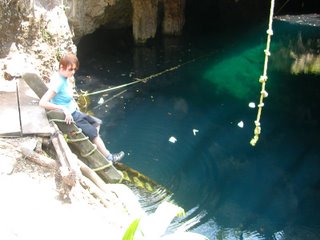 Christiane in cenote
Christiane in cenoteOn our last evening, we were invited to a party at Bush’s (no relation) house. Bush is an amateur archaeologist but an expert nonetheless; and Lilia introduced us to a number of archaeologists who happened to be in town, including Chris and Ed who are working at Palenque. Interesting conversations, and I look forward to meeting all of them again at the beginning of July in Palenque for an informal conference on the latest astronomical research.
The following morning, I came out of the shower into the hotel room and Christiane, with a very serious look on her face, suggested I look at something in the shelves where we had placed our clothes. There was the largest, blackest, scorpion I have ever seen. It had been in her clothes and jumped out when she started packing. If it had been me, I would have screamed bloody murder, but she had not said a thing. We assume it had gotten into our suitcases when we were at the cabaña in Tulum. We mentioned it to the hotel staff when we left, and hopefully they thought that that was why we left. I had been following my grandparent’s advice to check my shoes each morning, but did not think to check everything else. From that point on, we very careful.
 Scorpion in hotel room, was my hand shaking??
Scorpion in hotel room, was my hand shaking??We headed to Valladolid in the center of the Yucatan peninsula where Lilia was born and where she had worked at the site of Ek Balaam, a relatively newly opened site with very well-preserved and unusual carved plaster facades. We passed by Cancun without stopping. It makes Miami Beach look old-fashioned, but still looks like Miami Beach. If you like big resorts, Cancun is the place for you, but there little else to do.
 One of the dozens of resort hotels in Cancun
One of the dozens of resort hotels in Cancun The main pyramid at Ek Balaam, note roofed over plaster relief area and the unusual rooms around the base of the pyramid
The main pyramid at Ek Balaam, note roofed over plaster relief area and the unusual rooms around the base of the pyramid
 Plaster bas-relief facade
Plaster bas-relief facadeAfter Valladolid and Ek Balaam, we headed on to Mérida, which we had last seen in 1972. It is bigger, busier and dustier than we remembered. But before we got there, we stopped at Chichen Itzá, where my old prof, Peter S., is now in charge of archaeological research. Peter had been the Belice national archaeologist before I met and worked with him in Cholula/Puebla. After his stint with the German Foundation in Puebla, he moved back to the Maya area and has been stationed in Mérida and Chichen Itzá ever since. We went to the research compound at the site and started asking around for him, and just as we were about to leave, Peter drove up. We had not seen each other in years, and it took a moment or two for it to dawn on him who we were. After abrazos (Mexican hugs) all around we went in and had coffee with some of the staff.
 Temple of the Warriors, Chichen Itzá
Temple of the Warriors, Chichen Itzá
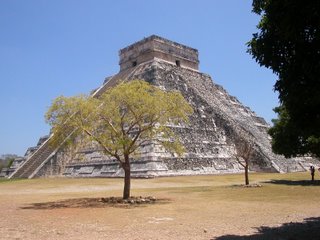
El Castillo, Chichen Itzá
Peter then dropped his schedule and took us on a three hour tour of his most recent work at Chichen Viejo (or old Chichen, actually not that much older than the rest of the site). This area was not open to tourism yet, so it was very quiet with only Peter, his administrative assistant, Christiane and me, and a small crew moving building stones from one pile to another. Not only did we feel exceptionally privileged to be the only ones allowed access, but being guided by the head guy who is also a friend, made it especially fun, entertaining, and educational. I had forgotten how funny Peter can be, and how much fun we had had in Puebla all those years ago.
 Peter and an atlante (humanoid column), Chichen El Viejo
Peter and an atlante (humanoid column), Chichen El Viejo Peter and Christiane in restored room of building in old Chichen
Peter and Christiane in restored room of building in old Chichen
 Tom and Peter looking from palace room to Classic Period dump
Tom and Peter looking from palace room to Classic Period dumpPeter noted that Chichen gets about 8,000 visitors a day from the resorts in Cancun, and if only one in a thousand rips off an artifact, defaces a monument, or goes postal etc., that is eight a day. It keeps the staff hopping. Things have gotten to the point that within the last year or so, they have restricted access to el Castillo and the Temple of the Warriors where I had carried Mamita when she was one and a half back in 1972. Back then there were only a handful of partially filled buses a day from Mérida, and the experience was more like ours with Peter had been. Tourism is seen as economic salvation in many areas of the world and in many parts of Mexico, but it comes at a price, which is why site protection and interpretation have become so important, not just in Mexico, but in Europe and most everywhere else.
We stayed the night in Mérida at Lilia’s family’s old house in the historic district (no AC), and met up with Israel, Lilia’s main employee. Israel is a lawyer and has a master’s in anthropology too. The combination will make him, and others like him, critical to the development of indigenous areas in Mexico. Unfortunately, there are not many others like him or like Lilia, for that manner.

Israel and Tom in Mérida
From Mérida we started back to Querétaro, a three day trip. The first day we stopped at Labna and Sayil, late classic sites in the Puuc region where Grandmother and Granddad had spent so many years. Reading their account of their arrival in the area, and being able to put it together with places that have not changed much since they were here was thought provoking, to say the least. Again we were surrounded by French tourists with the same guide book (Le Guide Routard), and very few Cancun (or American) tourists.
 The 350 Room (more or less) Palace at Sayil
The 350 Room (more or less) Palace at SayilWe spent the night in Ciudad del Carmen, near where Cortes’ crew was set upon and badly routed, and which is just a large disagreeable and dirty city these days. The next night we stopped in Puebla, after being delayed for several hours by a serious accident on the toll road climbing the mountains near Orizaba.
The following morning, we figured we had enough time for some sightseeing (site seeing?); and because I had not seen Cacaxtla since it was first discovered back in 1975 and because it had figured prominently in my thesis and in our recent conversations with Peter, we stopped and spent an hour or so there. The site is now covered by a large roof, unique to archaeological sites in Mexico and probably all of North America. It was discovered by some pot hunters who let the word out that they had found some painted murals. A couple of weeks later, Peter learned about it from the local archaeologists, and we visited it soon after. Among other unique attributes, Cacaxtla has a temple with a painted mural around its base showing the local population being subjugated and literally torn limb from limb by a conquering group of Maya. Since this is a thousand miles from the Maya area, what were they doing here? Subsequent work by Diana Lopez (who was a recent graduate in 1975) has answered some questions and produced a lot more questions.
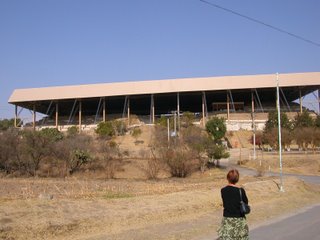 The Roof Covering the Main Part of Cacaxtla
The Roof Covering the Main Part of Cacaxtla
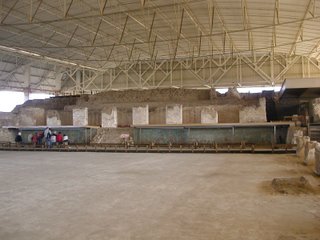 Mural at the Base of the Temple at Cacaxtla
Mural at the Base of the Temple at Cacaxtla
 Mural Close-up of Prisoner with Entrails and Assorted Body Parts
Mural Close-up of Prisoner with Entrails and Assorted Body Parts For me, the most interesting thing about the site is that it filled a gap in the prehistory of the Huejotzingo valley, where it is located. Until Cacaxtla, the common interpretation had been that the valley had been abandoned after the fall of Teotihuacan and only repopulated in the post-classic period by Nahuatl speakers which includes the Aztec, among others. As part of the work I did for Peter, I developed a ceramic typology for material collected from the upper slopes of the volcanoes (Popocatepetl and Iztacihuatl) to the middle of the valley floor. We collected everything, not just the pretty stuff and not just the stuff in the easy to find sites.
This typology included a series of ceramic types that did not compare to any of the established ceramic types in the region, and seemed to belong to the time period after the fall of Teotihuacan. We were at a loss as to what it meant at first, and we really had not had time to study where these types were found and what they were associated with.
To our surprise and delight, when we visited Cacaxtla, the ground was littered with this type of ceramic, almost exclusively. This fact coupled with the recently found murals, and the defensive location of the site (on an easily protected promontory on the edge of the valley, where previous investigators had not bothered to look since it did not follow their preconceived notions of where sites should be), helped fill in a major gap in the settlement history of the region with implications for the entire central highlands of Mexico in the period after Teotihuacan.
The people had not left the valley, they had simply moved to more easily protected areas in the foothills because of the invasion of Maya peoples who were filling the vacuum left by the fall of Teotihuacan. It was truly a eureka moment, and helped focus my thesis.
Over the intervening 30 years the murals and site have been protected as well as possible short of complete reburial. This includes the roof, drop down shades for the murals, and barriers for tourists, etc. But the paint colors have faded drastically, and in another 50-100 years they will only be available for study via photographs.
That afternoon we arrived back in Querétaro and had only a couple of days to get ready for Anne Caroline’s Easter break visit.
 End of the School Year Party for AIS, Christiane and her Buddies
End of the School Year Party for AIS, Christiane and her Buddies Nat and Benn, Chapel Hill, May 2006
Nat and Benn, Chapel Hill, May 2006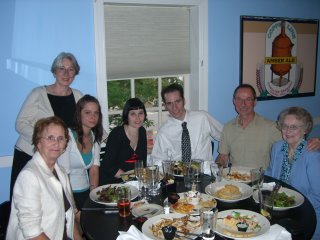 Benn's Mother, Patricia; Sister, Julie; Father, Donn; and Grandmother, Irene, in Chapel Hill; Plus Nat, Benn and Christiane
Benn's Mother, Patricia; Sister, Julie; Father, Donn; and Grandmother, Irene, in Chapel Hill; Plus Nat, Benn and Christiane
